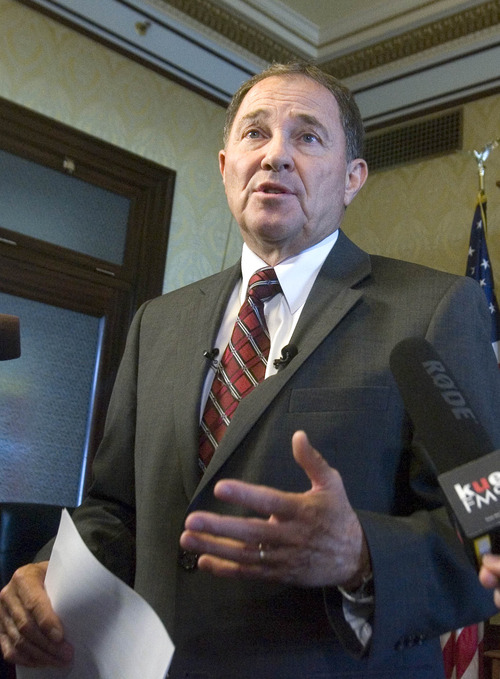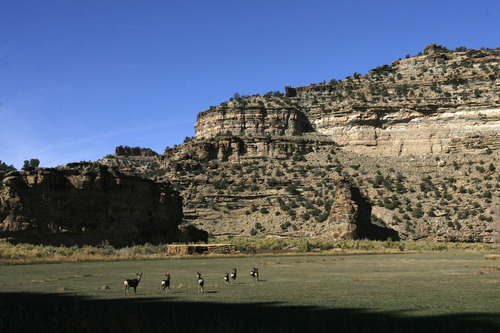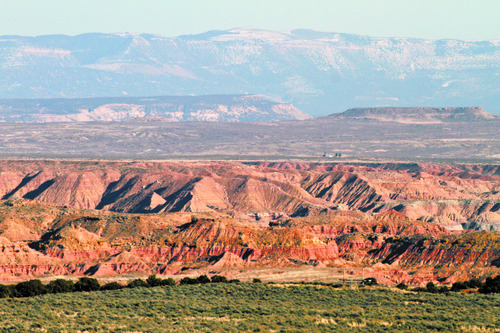This is an archived article that was published on sltrib.com in 2013, and information in the article may be outdated. It is provided only for personal research purposes and may not be reprinted.
State-owned roadless holdings in Utah's southern Book Cliffs, the area around Bogart Canyon cherished by sportsmen and environmentalists, also holds the area's most promising oil prospects that could send a gusher of at least $120 million in royalties to schools each year.
That's according to state-lands managers, who appeared before the Utah State Board of Education Friday morning explaining why they won't reconsider their Aug. 20 decision to lease the Book Cliffs for oil exploration, despite criticism over a lack of public involvement. Over the objections of Utah Gov. Gary Herbert and Rep. Rob Bishop, the state School and Institutional Trust Lands Administration (SITLA) intends to sign a deal next week with the global energy player Anadarko to drill state lands, including a scenic, remote wildlife-filed landscape along the Tavaputs Plateau in Grand County.
The controversy has divided state government, which usually is united in embracing energy development, and has raised questions about the independence and operations of SITLA, charged with managing 3.3 million acres of state land to raise money for a permanent education trust fund.
"The decision we made was not a rash decision made without all the facts. We would make the same decision today," SITLA board chairman Steven Ostler said. "This issue is testing SITLA's very mandate, the reason it was established [in 1994]. Clearly the law states that when SITLA lands are involved, the board has no other job than to maximize the value of the trust."
—
Secrecy • But key Utah political leaders argued SITLA's secret dealings with Anadarko excluded the interests and views of Utah citizens, the actual owners of these lands.
"Process counts. If you were a citizen trying to follow this, you couldn't follow it. Non-disclosure agreements made that impossible. There was nothing on the SITLA agenda [for the Aug. 20 meeting] that would infer this was being discussed," Lt. Gov. Greg Bell said. Herbert and Bishop, he added, "are not saying don't do this deal. They are saying there is a bigger deal that we have to be aware of. I ask you not to rush into this without understaing all the implications."
The Education Board voted unanimously to endorse SITLA's decision to lease most of the state's 120,000-acre Book Cliffs block, but not before a contentious debate on whether to seek ways to exclude the 18,000-acre Bogart unit — or at least delay a decision to lease there.
"I'm sad to be in a situation today where I'm on a different side than I want to be," said board member Leslie Castle, holding back tears. "I believe in wilderness and I believe drilling destroys wilderness. I am very sad Utahns have to dismantle their greatest natural resource to fund education. That is a tragedy."
In a joint letter to the Education Board, Bishop and Herbert contend SITLA failed to consider the downsides of leasing this southern-most piece in the Anadarko deal. This is the very patch that Utah's hunting community has asked be spared from mineral development as part of the Bishop-led "Grand Bargain," a series of ongoing negotiations aimed at resolving Utah's long-running public lands battles.
Putting these battles to rest would enable mining and drilling in areas that have been indefinitely locked up as wilderness study areas, Bishop said. Leasing Bogart Canyon could throw a monkeywrench into the delicate process, ultimately costing the school trust far more than what it could earn in the Anadarko deal.
—
'Blinders' • "If people put the blinders on and say, 'to hell with everything else,' that complicates the issue," Bishop told the Education Board. "We are asking you to be mellow and be happy and be flexible."
He asked that the Anadarko contract be written to enable SITLA to offer up substitute parcels that the company could develop in exchange for not drilling the southern Book Cliffs.
In the end, the board's response was no. Asking Anadarko to back off Bogart Canyon would devalue the overall lease and cost the school trust a potentially lucrative stream of revenue, amounting to $6 million or more per well, some members said. Any traded leasehold for federal minerals would shrink SITLA's royalty cut by nearly two-thirds, from 17 to 6.25 percent.
Andarko is targeting eastern Utah's Mancos Shale, similar to formations in North Dakota that are now yielding billions in oil revenue. The company remains steadfast in wanting Bogart Canyonas part of the deal, according to SITLA director Kevin Carter.
"After countless approaches from the governor's office to reconsider they are still on board with leasing the entire area. Their model for the geology seems to indicate the richer deposits are further south," Carter said. "We think we can work with our lessee partner and do this development in such a way that it retains the majority of its natural character and still allow us to extract from it those things that are important."
He assured the board that drilling would not impede hunting and other public uses around Bogart Canyon, currently accessible only on foot and horseback. The state Division of Wildlife Resources has acquired many parcels there, which it manages as wildlife reserves.
Proposed terms of SITLA's Anadarko deal
The arrangement expected to be signed next week divides the 96,000-acre lease area into two prospects, called Three Pines and South Books, which is further divided into the One Eye Canyon and Bogart Canyon units. Exploration would come in stages from north to south, beginning as early as this fall on Three Pines, an area that has been under lease for years with various companies. Anadarko is negotiating with these companies to develop these existing leases. It is to recomplete an old well here by June 1, 2014, and drill two more over the following year.
The deal would require Anadarko to commence a 3D seismic survey on One Eye Canyon by July 1, 2015, and sink a test well within a year of that deadline. Bogart Canyon has an identical time table, but exactly two years behind. Anadarko would be required to "unitize," or consolidate all the individual leases in each of these areas, by certain dates.
The company is to pay the state a $2-per acre annual rent, a per-acre bonus, plus $100,000 for the option to lease the South Books, and a 17 percent royalty on the value of any oil and gas produced.











